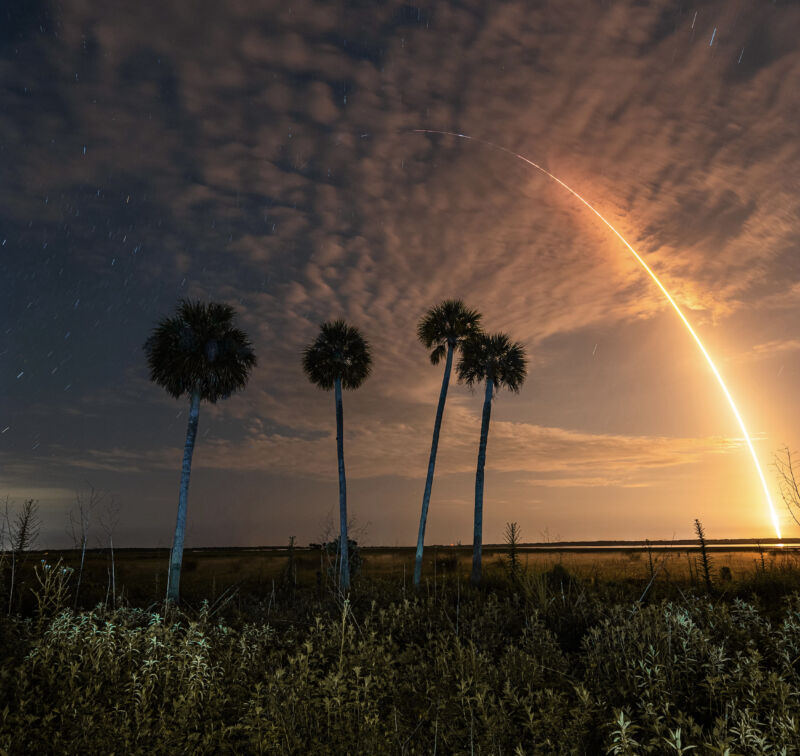4:45 am ET Wednesday Update: Beneath a starry Florida sky on Wednesday morning, a Falcon 9 rocket streaked spaceward carrying four astronauts. A few minutes later Commander Kjell Lindgren, Pilot Bob Hines, and Mission Specialists Jessica Watkins and Samantha Cristoforetti were safely in orbit. The Falcon 9 first stage, making its fourth flight, soon landed in the center of a drone ship.
All in all, it was SpaceX's seventh human spaceflight in less than two years, and its fifth crew mission for NASA to the International Space Station. This launch came just 19 days after the company's previous Crew Dragon flight, of the Axiom-1 mission, on April 8.
Shortly after reaching orbit the mission's commander, Lindgren, thanked the teams at SpaceX that developed the Crew Dragon spacecraft and Falcon 9 rocket for the smooth ride to space. "We're feeling great, and looking forward to the view," he radioed back down to Earth.
The crew will spend about 16 hours, and fire Dragon's thrusters a half a dozen times, to match its orbit to the International Space Station. Docking is expected at 8:15 pm ET on Wednesday (00:15 UTC Thursday).
Original post: On Monday afternoon, a Crew Dragon spacecraft named Endeavour splashed down in the Atlantic Ocean off the coast of Florida. Now, less than two days later, SpaceX and NASA are preparing another Crew Dragon for launch.
Monday's landing returned a crew of four private astronauts, whose 17-day spaceflight was sponsored by the private company Axiom Space. Since that vehicle's return, the manager of NASA's Commercial Crew Program, Steve Stich, said space agency and SpaceX engineers have been "poring over the data" on Dragon's performance during its return through the atmosphere.
"It was a very clean flight overall, with really no major issues," Stich said Tuesday morning during a press call with reporters. "The team has looked through a lot of the data, and they've had a chance to review everything. They've looked at the thermal protection system. They have looked at a lot of the GNC (guidance, navigation, and control) data from the flight. Obviously, the parachutes were very clean this flight. The mains all deployed and went to full open, almost in unison, with no indication of any laggard this time, which was great."
NASA officials were confident enough in Dragon's performance to clear a new Crew Dragon crew capsule, Freedom, for launch at 3:52 am ET (07:52 UTC) on Wednesday morning from Kennedy Space Center. This Crew-4 flight will carry Commander Kjell Lindgren, Pilot Bob Hines, and Mission Specialist Jessica Watkins, all NASA astronauts, as well as European Space Agency Mission Specialist Samantha Cristoforetti to the station. Weather at both the launch site and for the downrange abort zones looks fine.
Five days after Freedom docks with the space station, the four members of the Crew-3 mission that launched in November will begin their journey back to Earth. This five-day handover will ensure a continued presence of NASA astronauts on the space station.
The return of Crew-3 will mark the completion of SpaceX's sixth human spaceflight in less than two years. "That's truly remarkable, because all of this has been done through the pandemic," said Jessica Jensen, vice president of customer operations and integration at SpaceX, on Tuesday morning.
SpaceX now has a fleet of four Crew Dragon vehicles: Endeavour, Resilience, Endurance, and Freedom. Company officials have said that, for now, SpaceX does not intend to build any more Crew Dragons. On Monday, the company's director of human spaceflight programs, Benji Reed, said he thinks SpaceX can presently support as many as six human spaceflights a year. This is a likely breakdown of those missions:
- Two NASA flights to the International Space Station (until Boeing's Starliner vehicle becomes operational, and then this number would be one)
- Two private astronaut missions to the International Space Station, backed by Axiom Space or other private companies
- Two free-flying missions, such as the Inspiration4 and Polaris flights
Jensen said SpaceX is determined to continue flying humans into space safely despite the rapid turnaround. "As exciting as this is, and as busy as everyone has been talking about, I just want to reiterate that safety is still and always the top priority," she said.
The webcast below should begin at midnight ET, or 04:00 UTC on Wednesday.
Crew-4 launch webcast



3175x175(CURRENT).thumb.jpg.b05acc060982b36f5891ba728e6d953c.jpg)

Recommended Comments
There are no comments to display.
Join the conversation
You can post now and register later. If you have an account, sign in now to post with your account.
Note: Your post will require moderator approval before it will be visible.